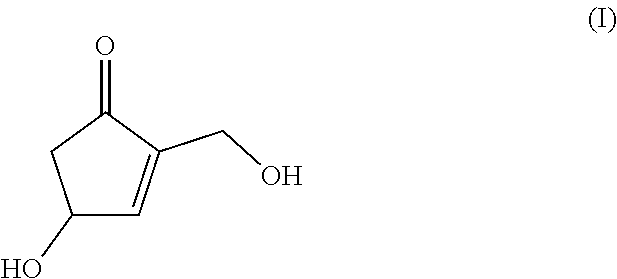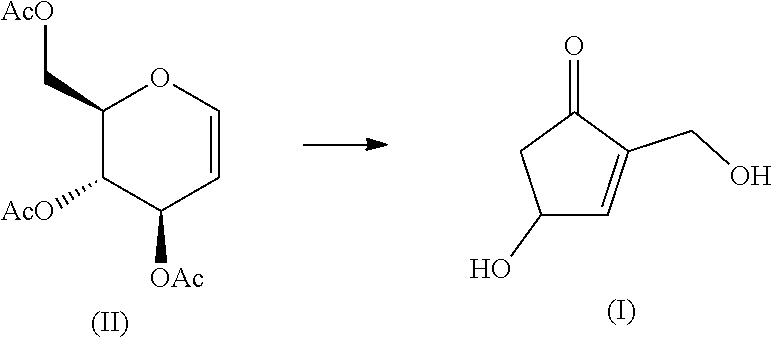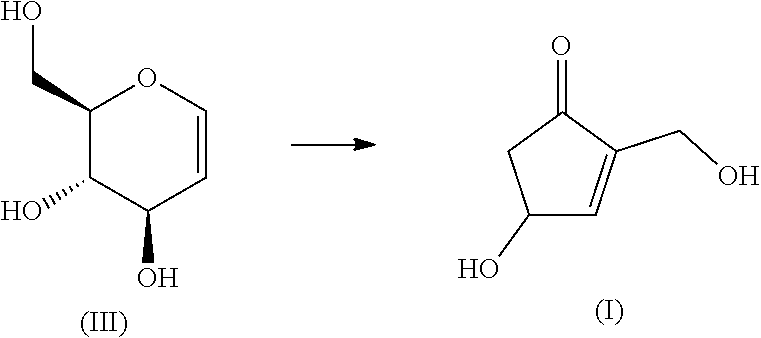Production method for cyclopentenone derivative
a production method and cyclopentenone technology, applied in the field of 4hydroxy2hydroxymethyl2cyclopentenone, can solve the problems of no production method proposed so far, high cost of 2-deoxy-aldohexose including 2-deoxyglucose as raw material, etc., and achieves high industrial utility value, low cost and high production efficiency.
- Summary
- Abstract
- Description
- Claims
- Application Information
AI Technical Summary
Benefits of technology
Problems solved by technology
Method used
Image
Examples
example 1
[0033]Water was added to tri-O-acetylglucal (II) (2.72 g, 10 mmol) to make the volume of 50 mL (0.2M). Then, heating (reaction) was started under pressure without evaporating the aqueous solution. The reaction temperature was set at 130° C. indicated by an autoclave device (Tomy Seiko, LSX-300) used for the reaction, and reacted for 18 hours. The reaction solution was filtered to remove solid components. The obtained yellow solution was poured into a column tube filled with synthetic resin SP207 (12.8 g), and then the reaction solution was repeatedly flowed until it became transparent. After it was eluted with 150 mL of water and the solvent was removed by distillation under reduced pressure, the residue was dissolved in 2-propanol. Then, hexane was added in double amount of 2-propanol, and the mixture was filtered through Celite to remove insoluble components. After removing the solvent by distillation under reduced pressure, the residue was purified with silica gel column chromato...
example 2
[0035]Tri-O-acetyl-D-glucal (2.72 g, 10 mmol) and sodium methoxide (27 mg, 0.5 mmol) were added and dissolved in 40 mL of methanol. After stirring for 1 hour, 400 μL of 1.25M HCl solution in methanol was added and stirred for 10 minutes to neutralize. The neutralized reaction solution was filtered using 5.44 g of neutral silica gel, and then eluted with 150 mL of methanol. The solvent was removed by distillation under reduced pressure to give D-glucal (III). The compound of formula (III) obtained was proceeded to the next reaction without purification. Water was added to D-glucal (III) to give an aqueous solution of (III). Further, water, hydrochloric acid and an aqueous solution of sodium hydroxide were used to adjust the pH to an arbitrary value, and the volume was adjusted to 50 mL (0.2M). Then, heating (reaction) was started under pressure without evaporating the aqueous solution. The reaction temperature was set at 130° C. indicated by an autoclave device (Tomy Seiko, LSX-300) ...
PUM
| Property | Measurement | Unit |
|---|---|---|
| temperature | aaaaa | aaaaa |
| volume | aaaaa | aaaaa |
| concentration | aaaaa | aaaaa |
Abstract
Description
Claims
Application Information
 Login to View More
Login to View More - R&D
- Intellectual Property
- Life Sciences
- Materials
- Tech Scout
- Unparalleled Data Quality
- Higher Quality Content
- 60% Fewer Hallucinations
Browse by: Latest US Patents, China's latest patents, Technical Efficacy Thesaurus, Application Domain, Technology Topic, Popular Technical Reports.
© 2025 PatSnap. All rights reserved.Legal|Privacy policy|Modern Slavery Act Transparency Statement|Sitemap|About US| Contact US: help@patsnap.com



